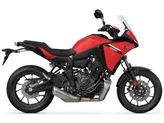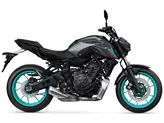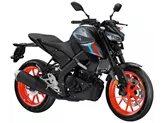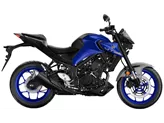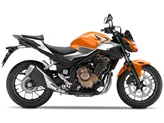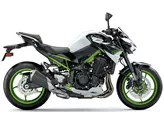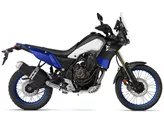Kawasaki ER-6n 2011 vs. Yamaha MT-07 2016

Kawasaki ER-6n 2011

Yamaha MT-07 2016
Vue d’ensemble - Kawasaki ER-6n 2011 vs Yamaha MT-07 2016
The Kawasaki ER-6n 2011 and the Yamaha MT-07 2016 are both naked bikes with similar engine types, inline 2-cylinder engines with liquid cooling. However, there are some notable differences between the two models.
In terms of engine power, the Yamaha MT-07 2016 has a slight advantage with 75 HP compared to the Kawasaki ER-6n 2011's 72 HP. The torque is also slightly higher on the Yamaha MT-07 with 68 Nm compared to the Kawasaki ER-6n's 66 Nm. Both bikes have a displacement of around 650ccm.
In terms of chassis, both bikes have a steel frame, which provides stability and durability. However, the Kawasaki ER-6n 2011 has a slightly longer wheelbase of 1410mm compared to the Yamaha MT-07 2016's 1400mm. This may result in slightly different handling characteristics.

Kawasaki ER-6n 2011
In terms of braking, both bikes have double disk brakes at the front. The Yamaha MT-07 2016 is praised for its powerful brakes, which provide excellent stopping power. The Kawasaki ER-6n 2011 also has ABS, which enhances safety by preventing the wheels from locking up during hard braking.
In terms of dimensions and weights, the Yamaha MT-07 2016 is lighter than the Kawasaki ER-6n 2011. The Yamaha MT-07 has a kerb weight of 179 kg (182 kg with ABS), while the Kawasaki ER-6n weighs 204 kg (208 kg with ABS). The Yamaha MT-07 also has a slightly lower seat height of 805mm compared to the Kawasaki ER-6n's 790mm.
In terms of tire width, both bikes have a front tire width of 120mm. However, the Yamaha MT-07 2016 has a wider rear tire with a width of 180mm, compared to the Kawasaki ER-6n 2011's 160mm rear tire. This may provide better traction and stability for the Yamaha MT-07.
In terms of fuel tank capacity, the Kawasaki ER-6n 2011 has a larger capacity of 15.5 liters compared to the Yamaha MT-07 2016's 14 liters. This may result in a longer range for the Kawasaki ER-6n.

Yamaha MT-07 2016
In terms of strengths, the Kawasaki ER-6n 2011 has ABS, wider handlebars, a slimmer waist, increased intake noise, a comfortable seat, and an uncomplicated chassis. On the other hand, the Yamaha MT-07 2016 has a very agile engine, very easy handling, low weight, an aggressively angular look, powerful brakes, a comfortable seating position, a throaty sound, and an extensive and easy-to-read display.
In terms of weaknesses, the Kawasaki ER-6n 2011 does not have any notable weaknesses. However, the Yamaha MT-07 2016 has a slightly soft chassis, footrests that may drag, partly cheap plastic parts, and a boring telescopic fork.
Overall, both the Kawasaki ER-6n 2011 and the Yamaha MT-07 2016 are solid naked bikes with their own strengths and weaknesses. The choice between the two would depend on individual preferences and priorities, such as power, weight, handling, and design.
Caractéristiques techniques Kawasaki ER-6n 2011 par rapport à Yamaha MT-07 2016
Avantages et inconvénients en comparaison
Avantages et inconvénients en comparaison
Kawasaki ER-6n 2011

Un ensemble aussi cohérent avec des détails aussi fins n'existe nulle part ailleurs à ce prix. L'ER-6n a retrouvé un peu de piquant sur le plan visuel et dynamique et est plus amusante que jamais.
Yamaha MT-07 2016

La MT-07 est une incroyable machine de plaisir qui se laisse conduire de manière extrêmement sportive. Le moteur est de loin le plus agile de sa catégorie, et même au-delà.
Comparaison des prix Prix moyen du marché Kawasaki ER-6n vs Yamaha MT-07
There are a few key differences between a Kawasaki ER-6n 2011 and a Yamaha MT-07 2016. In terms of price, the actual average price of a Yamaha MT-07 2016 is about 57% higher. A Kawasaki ER-6n 2011 experiences a loss of 230 USD in one year and 500 USD in two years of ownership. This is offset by a loss of 390 USD and 710 USD for a Yamaha MT-07 2016. Compared to Yamaha MT-07 2016 there are less Kawasaki ER-6n 2011 bikes available on the 1000PS.de Marketplace, specifically 5 compared to 24. It takes less time to sell a Kawasaki ER-6n with 49 days compared to 51 days for a Yamaha MT-07. Since model year 2006 1000PS.de editors have written 16 reviews for the Kawasaki ER-6n and 69 reviews for the Yamaha MT-07 since model year 2013. The first review for the Kawasaki ER-6n was published on 6/29/2005 and now has more than 11,200 views. This compares to more than 12,600 views for the first review on Yamaha MT-07 published on 11/4/2013.


